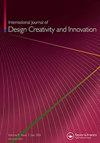Incremental to radical ideas: paradigm-relatedness metrics for investigating ideation creativity and diversity
IF 2.5
Q4 ENGINEERING, MANUFACTURING
International Journal of Design Creativity and Innovation
Pub Date : 2019-04-03
DOI:10.1080/21650349.2018.1463177
引用次数: 6
Abstract
Abstract Creativity and diversity are key components of success in idea generation, but each includes many dimensions. Paradigm-relatedness is an indicator of the style of creativity and diversity that has been overlooked often in assessing ideation. The goals for this study were to synthesize the literature on paradigm-relatedness, and develop and test alternative approaches for operationalizing paradigm-relatedness in ideation. The synthesis of the literature focused on reviewing both paradigm-relatedness theoretical frameworks and methodological approaches. Then, two alternative paradigm-relatedness metric approaches—category-based and component-based—were developed. Finally, ideation data was collected and coded to evaluate the reliability, ease of use, and potential applications of each approach. The category-based approach was a more reliable and faster way to code paradigm-relatedness, and so it may be more suited for research or evaluation at scale. In contrast, the component-based approach provided more explicit information on all aspects of paradigm-relatedness, but was more challenging to code reliably and more time-consuming. The component-based approach may be more suited to guiding smaller teams or individual designers in achieving paradigm-relatedness creativity and diversity. Neither approach was found to be universally ideal, and so consideration of the trade-offs is important in deciding which is most appropriate in a given situation.从渐进到激进的思想:用于调查思维创造力和多样性的范式相关性指标
摘要创造力和多样性是思想生成成功的关键组成部分,但每一个都包括许多维度。范式相关性是创造力和多样性风格的一个指标,在评估思维时经常被忽视。本研究的目的是综合有关范式相关性的文献,并开发和测试在构思中操作范式相关性的替代方法。文献综述侧重于回顾范式相关性理论框架和方法论方法。然后,开发了两种可供选择的范式相关性度量方法——基于类别和基于组件。最后,收集并编码构思数据,以评估每种方法的可靠性、易用性和潜在应用。基于类别的方法是一种更可靠、更快地编码范式相关性的方法,因此它可能更适合大规模的研究或评估。相比之下,基于组件的方法提供了关于范式相关性各个方面的更明确的信息,但更难可靠地进行编码,也更耗时。基于组件的方法可能更适合指导较小的团队或个人设计师实现范式相关性、创造性和多样性。这两种方法都不是普遍理想的,因此在决定哪种方法在特定情况下最合适时,考虑权衡是很重要的。
本文章由计算机程序翻译,如有差异,请以英文原文为准。
求助全文
约1分钟内获得全文
求助全文
来源期刊

International Journal of Design Creativity and Innovation
ENGINEERING, MANUFACTURING-
CiteScore
3.80
自引率
27.80%
发文量
15
期刊介绍:
The International Journal of Design Creativity and Innovation is an international publication that provides a forum for discussing the nature and potential of creativity and innovation in design from both theoretical and practical perspectives. Design creativity and innovation is truly an interdisciplinary academic research field that will interest and stimulate researchers of engineering design, industrial design, architecture, art, and similar areas. The journal aims to not only promote existing research disciplines but also pioneer a new one that lies in the intermediate area between the domains of systems engineering, information technology, computer science, social science, artificial intelligence, cognitive science, psychology, philosophy, linguistics, and related fields. The journal covers, but is not restricted to, the following topics: ·Theories on Design Creativity and Innovation ·Cognition of Design Creativity ·Innovative Process ·Inventive Process ·Analogical Reasoning for Design Creativity and Innovation ·Design Synthesis ·Method and Tools for Design Creativity and Innovation ·Representation of Design Creativity and Innovation ·Education for Design Creativity and Innovation ·Concept Generation and Inspiration.
 求助内容:
求助内容: 应助结果提醒方式:
应助结果提醒方式:


